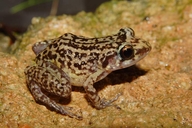|
Description
Eleutherodactylus simulans is a small frog, reaching 24 mm SVL in females and 18 mm in males. The skin of the dorsum is shagreened with scattered tubercles. The venter is smooth, slightly areolated on posterior edges. The digital discs are small. There is no webbing between the toes. The vomerine teeth, behind the choanae, are present in a long, arched series (Diaz and Fong 2001). This frog is light ochraceous-tan (yellowish tan) dorsally, with a dark brown mottled pattern. There are two light dorsolateral stripes, which begin behind the upper eyelids and are slightly wider on the anterior half of the body. The dorsal surface of the snout has irregular blotches and an irregular dark brown interorbital bar. There is a dark brown (almost black) loreal stripe, sometimes fragmented. The flanks are slightly olive green. The limbs are mottled, not distinctively crossbarred. The thighs are dark brown on their anterior and posterior faces. The venter is white or slightly flesh-colored, with the throat and chest showing scattered brown dots. The iris is golden yellow on the upper half and orange-red on the lower half (Diaz and Fong 2001). Distribution and Habitat
Country distribution from AmphibiaWeb's database: Cuba
This species is endemic to Cuba and it is known only from Sagua Baracoa mountains in eastern Cuba, at an elevation of less than 200 m. It occurs on the banks of mountain streams, hardwood forests, coffee plantations and around rural houses (Diaz and Fong 2001; Fong et al. 2005).Life History, Abundance, Activity, and Special Behaviors
This is a terrestrial frog found under rocks and logs by day. During the night it can be found along margins of streams, in the ground, on leaf litter, inside holes of the stream-side talus or on small stones. Males vocalize from these sites or hidden within grass clumps. Calls consist of soft “chips” with 1-2 notes and dominant frequency between 2.9-4.2 kHz. The first note is usually louder and higher pitched than the second note. Food includes spiders (Corinna sp.) and ants (Wasmannia auropunctata and Odontomachus sp.) (Diaz and Fong 2001). Trends and Threats
It is threatened by habitat destruction due to human settlements and agriculture (Hedges and Diaz 2004). Possible reasons for amphibian decline General habitat alteration and loss
Intensified agriculture or grazing
Urbanization
Comments
Eleutherodactylus simulans is a member of the subgenus Euhyas. (Heinicke et al., 2007)[3930]. Etymology- From the Latin simulans = resembling, referring to the external resemblance of this species to other known taxa (E. planirostris and E. ricordii) (Diaz and Fong 2001).
References
Díaz, L. M. and Fong, A. (2001). ''A new mottled frog of the genus Eleutherodactylus (Anura: Leptodactylidae) from eastern Cuba.'' Solenodon, 1, 76-84.
Fong, A. (2005). ''Amphibians and reptiles.'' Cuba: Siboney-JuticÃ. Rapid Biological Inventories Report 10. A. Fong, D. Maceira, W.S. Alverson, and J.M Shopland, eds., The Field Museum, Chicago, Illinois, USA.
Hedges, S. B. and Díaz, L. M. (2004). Eleutherodactylus simulans. In: IUCN 2007. 2007 IUCN Red List of Threatened Species. http://www.iucnredlist.org/. Downloaded on 11 November 2007.
Heinicke, M. P., Duellman, W. E., Hedges, S. B. (2007). ''Major Caribbean and Central American frog faunas originated by ancient oceanic dispersal.'' Proceedings of the National Academy of Sciences of the United States of America, 104(24), 10092-10097.
Originally submitted by: Ansel Fong G. (first posted 2007-11-07)
Edited by: Kellie Whittaker (2007-11-12)Species Account Citation: AmphibiaWeb 2007 Eleutherodactylus simulans: Oriente Mottled Frog <https://amphibiaweb.org/species/6159> University of California, Berkeley, CA, USA. Accessed May 30, 2025.
Feedback or comments about this page.
Citation: AmphibiaWeb. 2025. <https://amphibiaweb.org> University of California, Berkeley, CA, USA. Accessed 30 May 2025.
AmphibiaWeb's policy on data use.
|
